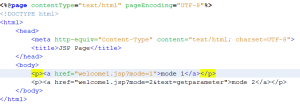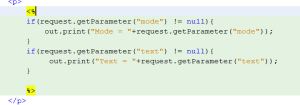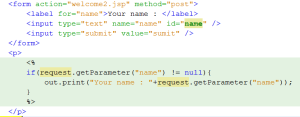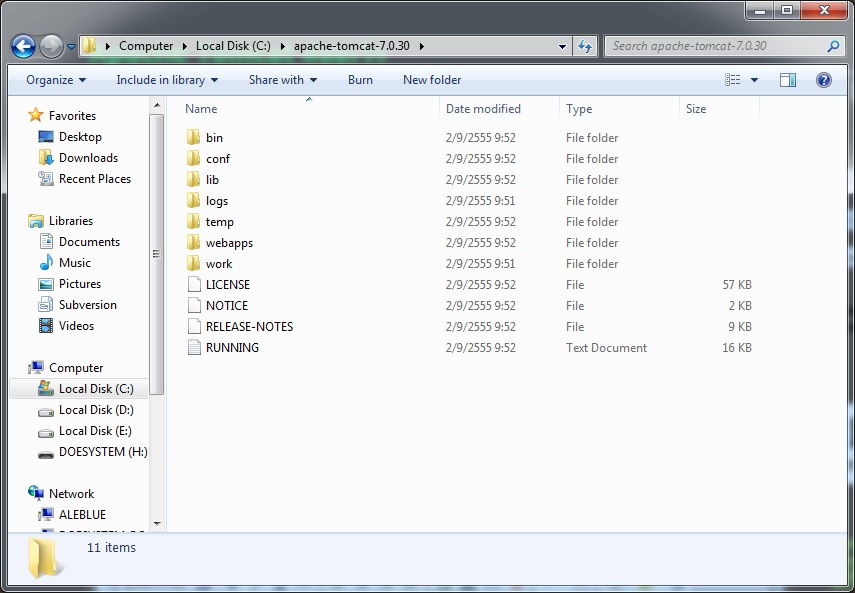Java Servlet
From Wikipedia, the free encyclopedia
A
Servlet is a
Java programming language class used to extend the capabilities of
servers that can be accessed by a host application via a
request-response programming model. Although servlets can respond to any type of request, they are commonly used to extend the applications hosted by
web servers. Thus, it can be thought of as a
Java Applet that runs on a
server instead of a
web browser.
[1]
Introduction
A
Servlet is a Java-based
server-side
web technology. As the name implies, it serves a client request and
receives a response from the server. Technically speaking, a
Servlet is a
Java class in
Java EE that conforms to the
Java Servlet API, a protocol by which a Java class may respond to requests. They are not tied to a specific
client–server protocol, but are most often used with the
HTTP protocol. Therefore, the word "Servlet" is often used in the meaning of "HTTP Servlet".
[2] Thus, a
software developer may use a servlet to add
dynamic content to a
web server using the
Java platform. The generated content is commonly
HTML, but may be other data such as
XML. Servlets are the
Java counterpart to non-Java dynamic Web content technologies such as PHP and
ASP.NET. Servlets can maintain
state in
session variables across many server transactions by using
HTTP cookies, or
URL rewriting.
To deploy and run a Servlet, a
web container
must be used. A web container (also known as a Servlet container) is
essentially the component of a web server that interacts with the
Servlets. The web container is responsible for managing the lifecycle of
Servlets, mapping a URL to a particular Servlet and ensuring that the
URL requester has the correct access rights.
The Servlet
API, contained in the
Java package hierarchy
javax.servlet, defines the expected interactions of the web container and a servlet.
[2]
A
Servlet is an
object
that receives a request and generates a response based on that request.
The basic Servlet package defines Java objects to represent Servlet
requests and responses, as well as objects to reflect the Servlet's
configuration parameters and execution environment. The package
javax.servlet.http defines
HTTP-specific
subclasses of the generic servlet elements, including session
management objects that track multiple requests and responses between
the web server and a client. Servlets may be packaged in a
WAR file as a
web application.
Servlets can be generated automatically from
JavaServer Pages (JSP) by the
JavaServer Pages compiler.
The difference between Servlets and JSP is that Servlets typically
embed HTML inside Java code, while JSPs embed Java code in HTML. While
the direct usage of Servlets to generate HTML (as shown in the example
below) has become rare, the higher level MVC web framework in Java EE (
JSF)
still explicitly uses the Servlet technology for the low level
request/response handling via the FacesServlet. A somewhat older usage
is to use Servlets in conjunction with JSPs in a pattern called "
Model 2", which is a flavor of the
model–view–controller pattern..
History
The complete Servlet specification was created by
Sun Microsystems, with version 1.0 finalized in June 1997. Starting with version 2.3, the Servlet specification was developed under the
Java Community Process.
JSR 53 defined both the Servlet 2.3 and JavaServer Page 1.2
specifications. JSR 154 specifies the Servlet 2.4 and 2.5
specifications. As of March 26, 2010, the current version of the Servlet
specification is 3.0.
In his
blog on
java.net, Sun veteran and
GlassFish lead Jim Driscoll details the history of Servlet technology.
James Gosling first thought of Servlets in the early days of
Java, but the concept did not become a product until Sun shipped the
Java Web Server[clarify] product. This was before what is now the
Java Platform, Enterprise Edition was made into a specification.
Servlet API history
| Servlet API version |
Released |
Platform |
Important Changes |
| Servlet 3.0 |
December 2009 |
JavaEE 6, JavaSE 6 |
Pluggability, Ease of development, Async Servlet, Security, File Uploading |
| Servlet 2.5 |
September 2005 |
JavaEE 5, JavaSE 5 |
Requires JavaSE 5, supports annotation |
| Servlet 2.4 |
November 2003 |
J2EE 1.4, J2SE 1.3 |
web.xml uses XML Schema |
| Servlet 2.3 |
August 2001 |
J2EE 1.3, J2SE 1.2 |
Addition of Filter |
| Servlet 2.2 |
August 1999 |
J2EE 1.2, J2SE 1.2 |
Becomes part of J2EE, introduced independent web applications in .war files |
| Servlet 2.1 |
November 1998 |
Unspecified |
First official specification, added RequestDispatcher, ServletContext |
| Servlet 2.0 |
|
JDK 1.1 |
Part of Java Servlet Development Kit 2.0 |
| Servlet 1.0 |
June 1997 |
|
|
Advantages over CGI
The advantages of using Servlets are their fast performance and ease of use combined with more power over traditional
CGI
(Common Gateway Interface). Traditional CGI scripts written in Java
have a number of disadvantages when it comes to performance:
- When an HTTP request is made, a new process is created for each call
of the CGI script. This overhead of process creation can be very
system-intensive, especially when the script does relatively fast
operations. Thus, process creation will take more time than CGI script
execution. Java Servlets solve this, as a Servlet is not a separate
process. Each request to be handled by a Servlet is handled by a
separate Java thread within the web server process, omitting separate
process forking by the HTTP daemon.
- Simultaneous CGI request causes the CGI script to be copied and
loaded into memory as many times as there are requests. However, with
Servlets, there are the same amount of threads as requests, but there
will only be one copy of the Servlet class created in memory that stays
there also between requests.
- Only a single instance answers all requests concurrently. This
reduces memory usage and makes the management of persistent data easy.
- A Servlet can be run by a Servlet container in a restrictive environment, called a sandbox. This is similar to an applet that runs in the sandbox of the web browser. This makes a restrictive use of potentially harmful Servlets possible.[2]
Life cycle of a Servlet
- During initialization stage of the Servlet life cycle, the web container initializes the Servlet instance by calling the
init() method, passing an object implementing the ServletConfig interface. This configuration object allows the Servlet to access name-value initialization parameters from the web application.
- After initialization, the Servlet can service client requests. Each request is serviced in its own separate thread. The web container calls the
service() method of the Servlet for every request. The service()
method determines the kind of request being made and dispatches it to
an appropriate method to handle the request. The developer of the
Servlet must provide an implementation for these methods. If a request
for a method that is not implemented by the Servlet is made, the method
of the parent class is called, typically resulting in an error being
returned to the requester.
- Finally, the web container calls the
destroy() method that takes the Servlet out of service. The destroy() method, like init(), is called only once in the lifecycle of a Servlet.
Therefore, three methods are central to the life cycle of a Servlet. These are
init(),
service(), and
destroy().
They are implemented by every Servlet and are invoked at specific times
by the server. The following is a typical user scenario of these
methods.
- Assume that a user enters a URL to a web browser.
- The browser then generates an HTTP request for this URL.
- This request is then sent to the appropriate server.
- The HTTP request is received by the web server and forwarded to the Servlet container.
- The Servlet container maps this request to a particular Servlet.
- The Servlet is dynamically retrieved and loaded into the address space of the Servlet container.
- The Servlet container invokes the
init() method of the Servlet.
- This method is invoked only when the Servlet is first loaded into memory.
- It is possible to pass initialization parameters to the Servlet so it may configure itself.
- The Servlet container invokes the
service() method of the Servlet.
- This method is called to process the HTTP request.
- You will see that it is possible for the Servlet to read data that has been provided in the HTTP request.
- It may also formulate an HTTP response for the client.
- The Servlet remains in the Servlet container’s address space and is
available to process any other HTTP requests received from clients.
- The
service() method is called for each HTTP request.
- The Servlet container may, at some point, decide to unload the Servlet from its memory.
- The algorithms by which this decision is made are specific to each Servlet container.
- The Servlet container calls the Servlet's
destroy()
method to relinquish any resources such as file handles that are
allocated for the Servlet; important data may be saved to a persistent
store.
- The memory allocated for the Servlet and its objects can then be garbage collected.
Example
The following example Servlet prints how many times its
service() method was called.
Note that
HttpServlet is a subclass of
GenericServlet, an implementation of the
Servlet interface.
The
service() method of
HttpServlet class dispatches requests to the methods
doGet(),
doPost(),
doPut(),
doDelete(), and so on; according to the HTTP request. In the example below method
service() is overridden and does not distinguish which HTTP request method it serves.
import java.io.IOException;
import javax.servlet.ServletConfig;
import javax.servlet.ServletException;
import javax.servlet.http.HttpServlet;
import javax.servlet.http.HttpServletRequest;
import javax.servlet.http.HttpServletResponse;
public class ServletLifeCycleExample extends HttpServlet {
private int count;
@Override
public void init(ServletConfig config) throws ServletException {
super.init(config);
getServletContext().log("init() called");
count=0;
}
@Override
protected void service(HttpServletRequest request, HttpServletResponse response)
throws ServletException, IOException {
getServletContext().log("service() called");
count++;
response.getWriter().write("Incrementing the count: Count = "+count);
}
@Override
public void destroy() {
getServletContext().log("destroy() called");
}
}
Usage
Servlets are most often used to
- process or store data that was submitted from an HTML form
- provide dynamic content such as the results of a database query
- manage state information that does not exist in the stateless HTTP
protocol, such as filling the articles into the shopping cart of the
appropriate customer.
See also
 หรืออ่านแบบเต็มๆได้จาก DWR: Easy AJAX for JAVA
หรืออ่านแบบเต็มๆได้จาก DWR: Easy AJAX for JAVA

















































